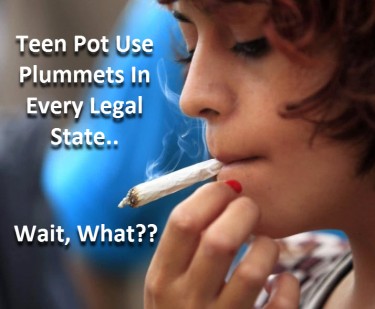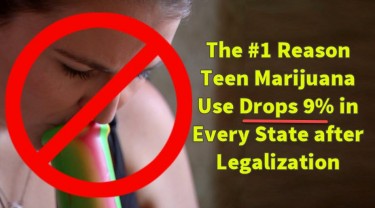
Teenage marijuana use has fallen off a cliff and the government wants to know why?
Cannabis prohibitionists like to argue with ridiculous claims that legalizing cannabis will be appalling and harmful to society.
One of their claims is that legalizing cannabis and making it available to the public will lead to drug addiction, especially among young people. However, we now have more evidence that it does the opposite, as widespread marijuana legalization actually does the opposite – resulting in a decline in teenage use.
Last month, the University of Michigan released its annual Monitoring-the-Future survey, which shows a dramatic year-over-year decline in cannabis use by adolescents – as well as other controlled substances. They found a 33% decrease among reported 8th grade cannabis use, a 38% decrease among 10th graders, and a 13% decrease among 12th grades. “The percentage of students who reported using marijuana (in all forms, including smoking and vaping) in the past year has decreased significantly among students in 8th, 10th and 12th grade,” the authors write.
“We have never seen such a dramatic drop in drug use among adolescents in just one year,” says Nora Volkow, director of the National Institute on Drug Abuse, who funded the study. “These data are unprecedented and highlight an unexpected potential consequence of the COVID-19 pandemic, which has caused seismic shifts in the daily lives of adolescents,” she says.
Dr. Volkow took part in a podcast last September 2021 with Ethan Nadelmann, who was once the director of the Drug Policy Alliance, who then said that national legalization of recreational cannabis across the country had not resulted in an increase in the number of young people who consume the drug. Then, in December, she said in an interview that there was no evidence that smoking cannabis did any harm.
“The Biden-Harris government is committed to using data and evidence to guide our prevention efforts. It is therefore important to identify all the factors that could have led to this decline in substance use in order to better inform prevention strategies, ”explains Dr. Rahul. Gupta, the White House director of national drug control policy. “The government is investing historic funds in evidence-based prevention programs because delaying substance use until after puberty greatly reduces the likelihood of developing substance use disorder.”
Monitoring the Future results also showed that cannabis use among adolescents between the ages of 12 and 17 has decreased significantly. “The latest evidence complements the growing scientific literature showing that marijuana regulation guidelines can be implemented to allow adult access while limiting access and abuse by adolescents,” said Paul Armetano, deputy director of NORML. He adds that the results are in line with many other studies showing that statewide cannabis legalization has neither increased nor made it easier for teenagers to use cannabis.
“Besides looking at these significant year-long drops in substance use among young people, the real benefit of Monitoring the Future is our unique ability to track changes over time and through history,” says the newspaper’s director Author, Richard A. Miech, Ph.D., who is also the survey team leader at the University of Michigan. “We knew this year’s data would shed some light on how the COVID-19 pandemic might have affected drug use among young people, and in the years to come, we’ll see if those effects are permanent as we track drug use patterns of further pursuing these unique cohorts of adolescents. “
Legalization is key to preventing cannabis use among adolescents
While cannabis use naturally has a wide range of benefits for both adults and sick children, it is not advisable for teenagers to consume it during leisure time due to their developing brains.
And that’s why legalization is so important that young adults don’t start using the drug until they are of legal age.
A study published in the Journal of the American Medical Association in September 2021, examining data from the state youth risk behavior survey from 1993 to 2019 in 10 states with either recreational or medical laws, adds to the evidence that cannabis reform is positive Consumption has an impact on minors. The authors did not hypothesize why underage children do not use cannabis as frequently in states with legal laws, although the trends are not surprising to those who argue that legal access to cannabis sales as long as it is in a regulated environment, would hinder the black market and restrict teenage access.
The researchers note that the Adult Use Act “has not been linked to current marijuana or frequent marijuana use.”
“Consistent with estimates from previous studies, there was little evidence that RML (Recreational Marijuana Law) or MML (Medical Marijuana Law) encouraged adolescent consumption,” the researchers said. “As more data becomes available after legalization, researchers will be able to draw more confident conclusions about the relationship between RMLs and adolescent marijuana use.”
“This study provides additional evidence that the legalization and regulation of cannabis does not lead to increased consumption among adolescents,” Matthew Schweich, deputy director of the Marijuana Policy Project, told Marijuana Moment. “In fact, it suggests that laws to legalize cannabis could reduce teenage use.”
“It makes sense because legal cannabis companies are required to strictly verify their customers’ IDs,” he added. “The unregulated market that the prohibitionists are effectively trying to maintain has no such protection.”
Older studies secure claims
The evidence continues to provide a stronger basis for these claims.
In 2019, a report published in JAMA Pediatrics showed that legal recreational marijuana laws were down 8% in high school students who used cannabis in the past 30 days and 9% down in those who admitted, connected had been used at least 10 times within the last 30 days.
“Just to be clear, we found no effects on teenage use after legalization for medical purposes, but evidence of a possible reduction in recreational use after legalization,” said Mark Anderson, associate professor at Montana State University and First author of the study.
“Because our study is based on more political variation than real work, we consider our estimates to be the most believable in the literature,” he says.
Conclusion
With cannabis legalization expected to become even more widespread this year, we expect the rate of cannabis use by minors to continue to decline. After all, legalization and regulation are critical to crushing the black market and ensuring cannabis gets into the right hands.
TEENS STOP USING WEED, READ MORE …

TEENS USE LESS WEED AFTER LEGALIZATION, DO YOU SAY WHAT?
OR..

THE NUMBER ONE REASON WHY TEENS STOP USING WEED AFTER LEGALIZATION?

Post a comment: